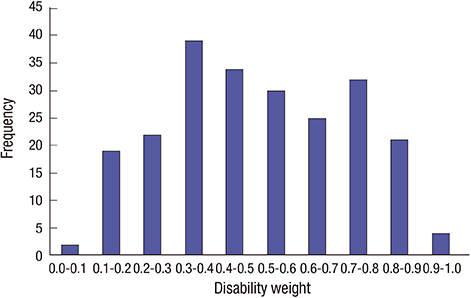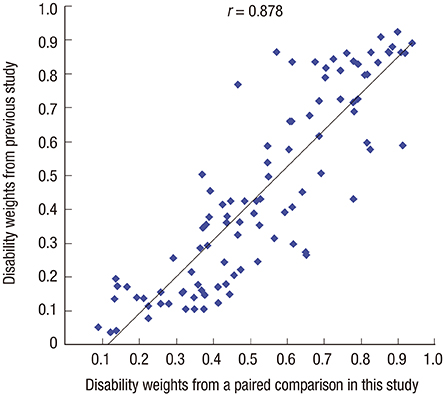Disability Weights Measurement for 228 Causes of Disease in the Korean Burden of Disease Study 2012
- Affiliations
-
- 1Department of Preventive Medicine, University of Ulsan College of Medicine, Seoul, Korea. mdjominwoo@gmail.com
- 2Public Health Medical Service, Seoul National University, Boramae Medical Center, Seoul, Korea.
- 3Department of Preventive Medicine, College of Medicine, Kyung Hee University, Seoul, Korea.
- 4Department of Preventive Medicine, School of Medicine, Ewha Woman's University, Seoul, Korea.
- 5Department of Preventive Medicine, Korea University, Seoul, Korea.
- KMID: 2360663
- DOI: http://doi.org/10.3346/jkms.2016.31.S2.S129
Abstract
- Disability weight for each disease plays a key role in combining years lived with disability and years of life lost in disability adjusted life year. For the Korean Burden of Disease 2012 study, we have conducted a re-estimation of disability weights for causes of disease by adapting the methodology of a recent Global Burden of Disease study. Our study was conducted through a self-administered web-based survey using a paired comparison (PC) as the main valuation method. A total of 496 physicians and medical college students who were attending in third or fourth grade of a regular course conducted the survey. We applied a probit regression on the PC data and computed the predicted probabilities of each cause of disease from the coefficient estimates of the probit regression. We used 'being dead (1)' and 'full health (0)' as anchor points to rescale the predicted probability of each cause of disease on a scale of 0 to 1. By this method, disability weights for a total of 228 causes of disease were estimated. There was a fairly high correlation between the disability weights of overlapping causes of disease from this study and a previous South Korean study despite the differences in valuation methods and time periods. In conclusion, we have shown that disability weights can be estimated based on a PC by including 'full health' and 'being dead' as anchor points without resorting to a person trade-off. Through developments in the methodology of disability weights estimation from this study, disability weights can be easily estimated and continuously revised.
MeSH Terms
Figure
Cited by 11 articles
-
The Burden of Disease due to COVID-19 in Korea Using Disability-Adjusted Life Years
Min-Woo Jo, Dun-Sol Go, Rhieun Kim, Seung Won Lee, Minsu Ock, Young-Eun Kim, In-Hwan Oh, Seok-Jun Yoon, Hyesook Park
J Korean Med Sci. 2020;35(21):e199. doi: 10.3346/jkms.2020.35.e199.Updating Disability Weights for Measurement of Healthy Life Expectancy and Disability-adjusted Life Year in Korea
Young-Eun Kim, Min-Woo Jo, Hyesook Park, In-Hwan Oh, Seok-Jun Yoon, Jeehee Pyo, Minsu Ock
J Korean Med Sci. 2020;35(27):e219. doi: 10.3346/jkms.2020.35.e219.Burden of Disease Due to Secondhand Smoke among Korean Adults at Sub-National Level
Aqeela Zahra, Jae-Hyun Park
J Korean Med Sci. 2018;33(40):. doi: 10.3346/jkms.2018.33.e256.The Burden of Acute Pesticide Poisoning and Pesticide Regulation in Korea
Seulki Ko, Eun Shil Cha, Yeongchull Choi, Jaeyoung Kim, Jong-Hun Kim, Won Jin Lee
J Korean Med Sci. 2018;33(31):. doi: 10.3346/jkms.2018.33.e208.The Korean National Burden of Disease Study: from Evidence to Policy
Seok-Jun Yoon, Dun-Sol Go, Hyesook Park, Min-Woo Jo, In-Hwan Oh, Young-Eun Kim
J Korean Med Sci. 2019;34(Suppl 1):. doi: 10.3346/jkms.2019.34.e89.Trends and Patterns of Burden of Disease and Injuries in Korea Using Disability-Adjusted Life Years
Young-Eun Kim, Hyesook Park, Min-Woo Jo, In-Hwan Oh, Dun-Sol Go, Jaehun Jung, Seok-Jun Yoon
J Korean Med Sci. 2019;34(Suppl 1):. doi: 10.3346/jkms.2019.34.e75.Incidence-Based versus Prevalence-Based Approaches on Measuring Disability-Adjusted Life Years for Injury
Bohyun Park, Bomi Park, Won Kyung Lee, Young-Eun Kim, Seok-Jun Yoon, Hyesook Park
J Korean Med Sci. 2019;34(Suppl 1):. doi: 10.3346/jkms.2019.34.e69.Disability Weights Measurement for 289 Causes of Disease Considering Disease Severity in Korea
Minsu Ock, Bomi Park, Hyesook Park, In-Hwan Oh, Seok-Jun Yoon, Bogeum Cho, Min-Woo Jo
J Korean Med Sci. 2019;34(Suppl 1):. doi: 10.3346/jkms.2019.34.e60.Projection of the Years of Life Lost, Years Lived with Disability, and Disability-Adjusted Life Years in Korea for 2030
Bomi Park, Bohyun Park, Hyejin Han, Eun Jung Choi, Nam-eun Kim, Yoonhee Shin, Hyesook Park
J Korean Med Sci. 2019;34(Suppl 1):. doi: 10.3346/jkms.2019.34.e92.Comprehensive Measurement of the Burden of Disease due to Adverse Events: A New Analysis of the Cross-Sectional Patient Safety Incident Inquiry
Eun Young Choi, Juyoung Kim, Won Lee, Seung Gyeong Jang, Jeehee Pyo, Minsu Ock
J Korean Med Sci. 2023;38(43):e337. doi: 10.3346/jkms.2023.38.e337.Korean National Burden of Disease: The Importance of Diabetes Management
Chung-Nyun Kim, Yoon-Sun Jung, Young-Eun Kim, Minsu Ock, Seok-Jun Yoon
Diabetes Metab J. 2024;48(4):518-530. doi: 10.4093/dmj.2024.0087.
Reference
-
1. Yoon J, Oh IH, Seo H, Kim EJ, Gong YH, Ock M, Lim D, Lee WK, Lee YR, Kim D, et al. Disability-adjusted Life Years for 313 Diseases and Injuries: the 2012 Korean Burden of Disease Study. J Korean Med Sci. 2016; 31:Suppl 2. S146–S157.2. Salomon JA, Mathers CD, Chatterji S, Sadana R, Ustun TB, Murray CJ. Quantifying individual levels of health: definitions, concepts and measurement issues. In : Murray CJ, Evans DB, editors. Health Systems Performance Assessment: Debate, Methods, and Empiricism. Geneva: World Health Organization;2003. p. 301–318.3. Lee YH, Yoon SJ, Kim A, Seo H, Ko S. Health Performance and Challenges in Korea: a Review of the Global Burden of Disease Study 2013. J Korean Med Sci. 2016; 31:Suppl 2. S114–S120.4. Salomon JA, Vos T, Hogan DR, Gagnon M, Naghavi M, Mokdad A, Begum N, Shah R, Karyana M, Kosen S, et al. Common values in assessing health outcomes from disease and injury: disability weights measurement study for the global burden of disease study 2010. Lancet. 2012; 380:2129–2143.5. Murray CJ, Lopez AD. The Global Burden of Disease: a Comprehensive Assessment of Mortality and Disability from Diseases, Injuries, and Risk Factors in 1990 and Projected to 2020. Cambridge, MA: Harvard University Press;1996.6. Stouthard ME, Essink-Bot ML, Bonsel GJ, Barendregt JJ, Kramers P, van de Water HP, Gunning-Schepers LJ, van der Maas PJ. Disability Weights for Diseases in the Netherlands. Rotterdam: Erasmus University;1997.7. Stouthard ME, Essink-Bot ML, Bonsel GJ. Disability weights for diseases. A modified protocol and results for a Western European region. Eur J Public Health. 2000; 10:24–30.8. Ustün TB, Rehm J, Chatterji S, Saxena S, Trotter R, Room R, Bickenbach J; WHO/NIH Joint Project CAR Study Group. Multiple-informant ranking of the disabling effects of different health conditions in 14 countries. Lancet. 1999; 354:111–115.9. Salomon JA, Haagsma JA, Davis A, de Noordhout CM, Polinder S, Havelaar AH, Cassini A, Devleesschauwer B, Kretzschmar M, Speybroeck N, et al. Disability weights for the global burden of disease 2013 study. Lancet Glob Health. 2015; 3:e712–23.10. Haagsma JA, Maertens de Noordhout C, Polinder S, Vos T, Havelaar AH, Cassini A, Devleesschauwer B, Kretzschmar ME, Speybroeck N, Salomon JA. Assessing disability weights based on the responses of 30,660 people from four European countries. Popul Health Metr. 2015; 13:10.11. Haagsma JA, Polinder S, Cassini A, Colzani E, Havelaar AH. Review of disability weight studies: comparison of methodological choices and values. Popul Health Metr. 2014; 12:20.12. Polinder S, Haagsma JA, Stein C, Havelaar AH. Systematic review of general burden of disease studies using disability-adjusted life years. Popul Health Metr. 2012; 10:21.13. Arnesen T, Nord E. The value of DALY life: problems with ethics and validity of disability adjusted life years. BMJ. 1999; 319:1423–1425.14. Rehm J, Frick U. Valuation of health states in the US study to establish disability weights: lessons from the literature. Int J Methods Psychiatr Res. 2010; 19:18–33.15. Groce NE. Disability in cross-cultural perspective: rethinking disability. Lancet. 1999; 354:756–757.16. Østerdal LP. The lack of theoretical support for using person trade-offs in QALY-type models. Eur J Health Econ. 2009; 10:429–436.17. Doctor JN, Miyamoto J, Bleichrodt H. When are person tradeoffs valid? J Health Econ. 2009; 28:1018–1027.18. Yoon SJ, Kwon YD, Kim BY. Estimating the disability weight of major cancers in Korea using Delphi method. Korean J Prev Med. 2000; 33:409–414.19. Lee JK, Yoon SJ, Do YK, Kwon YH, Kim CY, Park K, Kim YI, Shin YS. Disability weights for diseases in Korea. Korean J Prev Med. 2003; 36:163–170.20. Do YK, Yoon SJ, Lee JK, Kwon YH, Lee SI, Kim C, Park K, Kim YI, Shin Y. Disability weights for the Korean burden of disease study: focused on comparison with disability weights in the Australian burden of disease study. J Prev Med Public Health. 2004; 37:59–71.21. Yoon SJ, Bae SC, Lee SI, Chang H, Jo HS, Sung JH, Park JH, Lee JY, Shin Y. Measuring the burden of disease in Korea. J Korean Med Sci. 2007; 22:518–523.22. Choi KS, Park JH, Lee KS. Disability weights for cancers in Korea. J Korean Med Sci. 2013; 28:808–813.23. Institute for Health Metrics and Evaluation (US). GBD compare (South Korea) [Internet]. accessed on 24 November 2015. Available at http://vizhub.healthdata.org/gbd-compare/.24. de Bekker-Grob EW, Ryan M, Gerard K. Discrete choice experiments in health economics: a review of the literature. Health Econ. 2012; 21:145–172.25. Ali S, Ronaldson S. Ordinal preference elicitation methods in health economics and health services research: using discrete choice experiments and ranking methods. Br Med Bull. 2012; 103:21–44.26. Whitehead SJ, Ali S. Health outcomes in economic evaluation: the QALY and utilities. Br Med Bull. 2010; 96:5–21.27. Torrance GW, Feeny D, Furlong W. Visual analog scales: do they have a role in the measurement of preferences for health states? Med Decis Making. 2001; 21:329–334.28. Dolan P, Olsen JA, Menzel P, Richardson J. An inquiry into the different perspectives that can be used when eliciting preferences in health. Health Econ. 2003; 12:545–551.29. Jo MW, Ock M. Estimation of disability weights in the general population of South Korea using a paired comparison. In : Proceedings of the 37th Annual Meeting of the Society for Medical Decision Making; 2015 Oct 18-21; St. Louis, MO. Hillsborough, NJ: Society for Medical Decision Making;2015.30. Lim D, Ha M, Song I. Trends in the leading causes of death in Korea, 1983-2012. J Korean Med Sci. 2014; 29:1597–1603.31. Lim D, Ha M, Song I. Trends in major cancer mortality in Korea, 1983-2012, with a joinpoint analysis. Cancer Epidemiol. 2015; 39:939–946.
- Full Text Links
- Actions
-
Cited
- CITED
-
- Close
- Share
- Similar articles
-
- Review of Issues for Disability Weight Studies
- Disability Weights Measurement for 289 Causes of Disease Considering Disease Severity in Korea
- Disability Weights for the Korean Burden of Disease Study: Focused on Comparison with Disability Weights in the Australian Burden of Disease Study
- Updating Korean Disability Weights for Causes of Disease: Adopting an Add-on Study Method
- Disability Weights for Cancers in Korea



